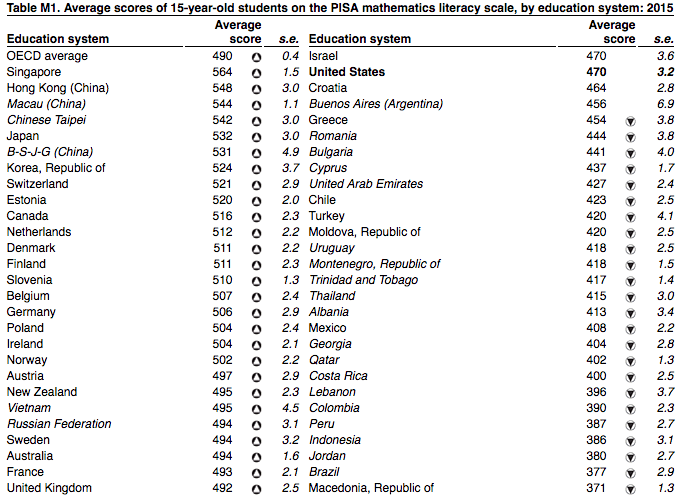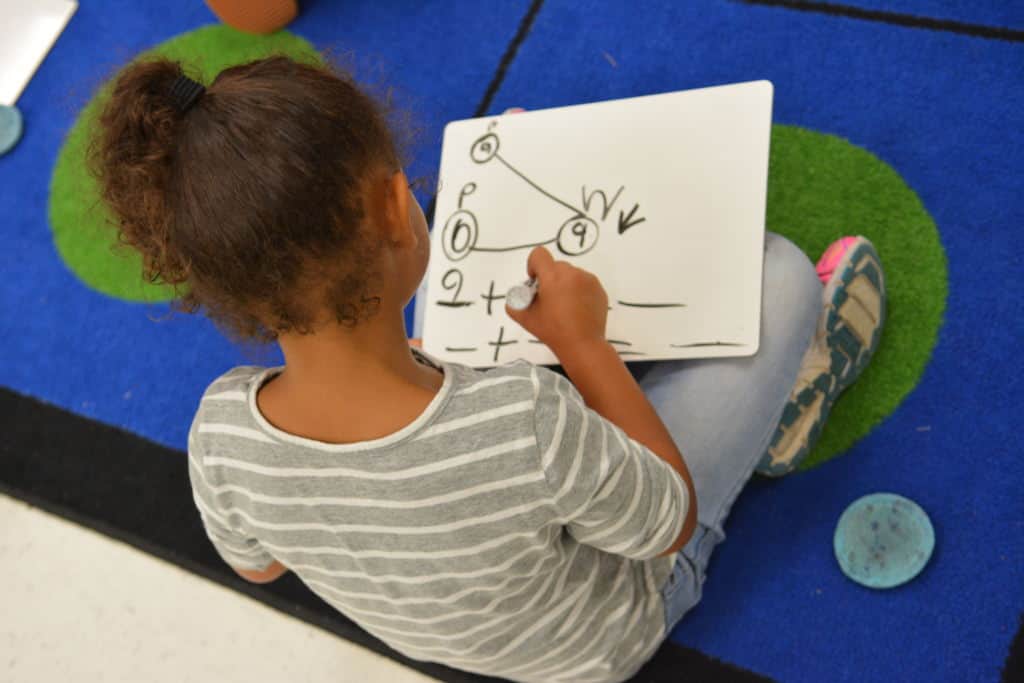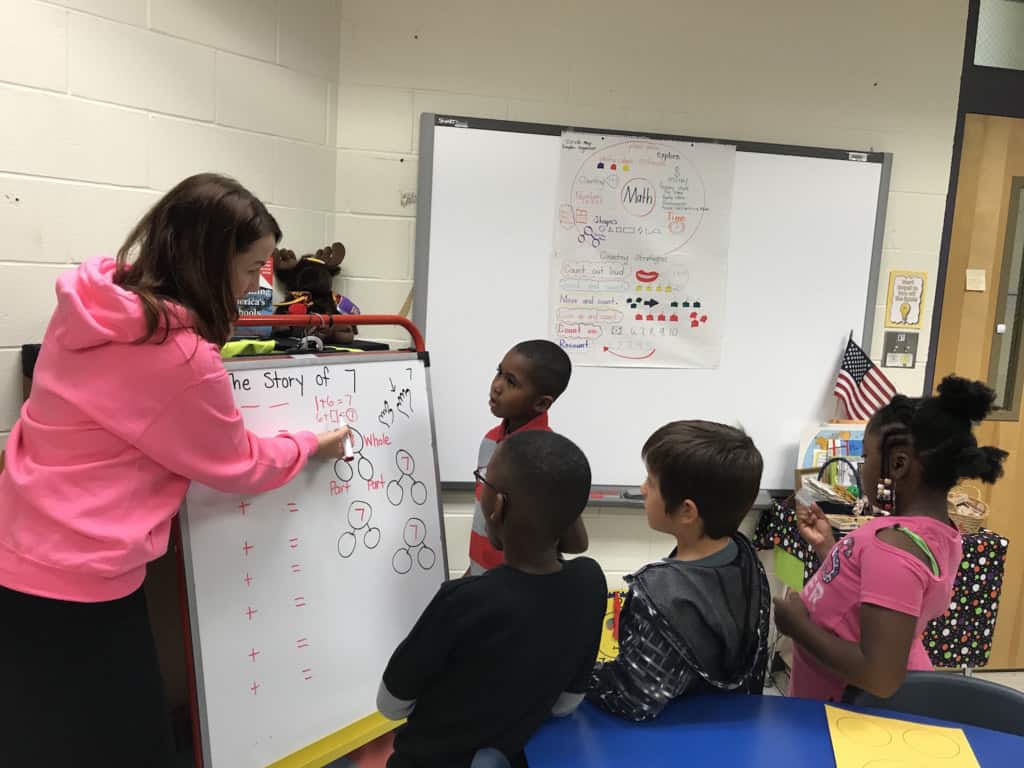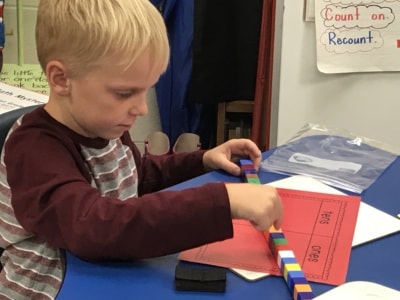

“I like math because I like how many different ways there are to show the answer.” – Jason Howard, 4th grade student
“I like math because of multiplication. I like multiplying big numbers using different strategies.” – Rhiana Hammond, 4th grade student
Students at Alderman Road Elementary in Fayetteville, North Carolina are excited about math — and not just about finding the right answer. They are excited about using different strategies to solve problems thanks to Singapore math.
Led by teacher-turned-instructional-coach Andi Webb, Alderman Road Elementary students have embraced Singapore math from kindergarten to fifth grade. Webb completed a Fulbright in Singapore to study how they teach math and has since trained several teachers at Alderman Road Elementary.


We spent two days with Webb and her math team colleagues at Alderman Road Elementary to get a better understanding of Singapore math and see why it has been so powerful at their school. They credit Singapore math for double-digit test scores in third grade math and a 10 point gain in fourth grade math proficiency scores over the past three years.


What is Singapore math?
Singapore math is a way to teach math that focuses on understanding the “why” before the “how.” Instead of teaching students to memorize the steps of long division or double-digit multiplication, for example, Singapore math focuses on teaching students to understand the concept of multiplying and dividing before asking them to learn the procedure.
Singapore math has gained national attention due to Singapore’s performance on international tests compared to the United States. On the 2015 Program for International Student Assessment (PISA) math test, Singapore had the highest average math score of 15-year-old students whereas the U.S scored below the OECD average.


Singapore math in the classroom: key features
Focus on developing number sense
Teachers at Alderman Road Elementary found Singapore math develops strong number sense, a skill with which their students struggle and is crucial for success in later grades. Number sense is a student’s ability to understand numbers and use them fluidly.
Marilyn Burns, author of About Teaching Mathematics, describes students with strong number sense as students who “can think and reason flexibly with numbers, use numbers to solve problems, spot unreasonable answers, understand how numbers can be taken apart and put together in different ways, see connections among operations, figure mentally, and make reasonable estimates.” If students fail to develop strong number sense in elementary school, they will struggle with more advanced math skills later.
Singapore math focuses on developing strong number sense, in particular understanding how numbers relate to one another and can be taken apart and put together. A key strategy is using number bonds to break numbers into their different parts (using part-part-whole diagrams).
Numbers bonds show how numbers can be combined or split up. In kindergarten and first grade, students were using number bonds to practice addition. During Webb’s small group instruction, her first graders were breaking the number seven into all of the different combinations that add up to seven. Fourth graders were using number bonds to practice multiplication and division facts.






CPA: Concrete, pictorial, abstract
Another key feature of Singapore math is the use of CPA, or concrete, pictorial, and abstract, to teach students new concepts. CPA is an approach to teaching math that helps students gain a conceptual understanding of abstract concepts.
In the U.S., teachers often introduce difficult concepts such as fractions by showing students how to solve an equation on the board. The CPA method introduces difficult concepts in a more tangible, hands-on way that makes it easier for students to understand.
The first step is concrete where students learn by doing. Teachers introduce new concepts using concrete objects that students can touch and manipulate. For example, in a lesson on addition, the teacher might start by having students handle manipulatives such as blocks and record what happens when they add more blocks to their existing ones.
The next step is pictorial. In this stage, students use models or representations of the objects to learn the concept. For the pictorial step of the addition lesson, students might model the problem using drawings of blocks.
Drawing a model of the problem helps students understand difficult concepts because it gives them a visual representation to work with instead of trying to solve a problem in their heads.


The last step is abstract, which is when teachers make the connection between model drawings and math symbols and equations. In the addition lesson, this is the step where students would learn to write an equation with numbers and symbols (+,=).


At Alderman Road Elementary, teachers move between concrete, pictorial, and abstract constantly. Because Singapore math emphasizes concrete and pictorial before moving to abstract, students and teachers were using manipulatives and model drawing in every grade.
In Webb’s lesson on the number seven, her students were using different combinations of blocks to add up to seven (concrete) and then writing the equation for that combination (abstract).
Fourth grade teacher Tiana Thompson was working on multiplication and division word problems with her students and having them move between drawing models of the problem (pictorial) and writing equations (abstract).


Multiple ways to solve a problem
When I was learning two-digit multiplication, my teacher would take points off our tests if we used the lattice method instead of traditional long-form multiplication. With Singapore math, students are taught multiple ways to solve a problem and encouraged to use the way that makes the most sense for them.
Students at Alderman Road Elementary loved this about their math classes. When two fourth grade students were asked what they liked best about math, they both responded that they liked using different strategies to solve problems.
Finding success with Singapore math
Teachers at Alderman Road Elementary believe Singapore math has made them better teachers and helped their students learn to love math.
“Singapore Math has helped my students gain confidence in themselves and their abilities as mathematicians . For them, having the ability to reason within a math problem gives them the ownership of what they are learning. Singapore Math helps strengthen students in problems they are solving, rather than simply giving them answers to remember.” – Cathleen Mabe
“I can’t speak for other grade levels, but I know that when I was remediating more advanced skills for my students, it was nice to have that mind frame of concrete, pictorial, and abstract to refer to. I remember one of the presenters saying that if a student doesn’t understand something, go backwards. Go straight back to concrete and work from there.” – Teacher at Alderman Road Elementary








